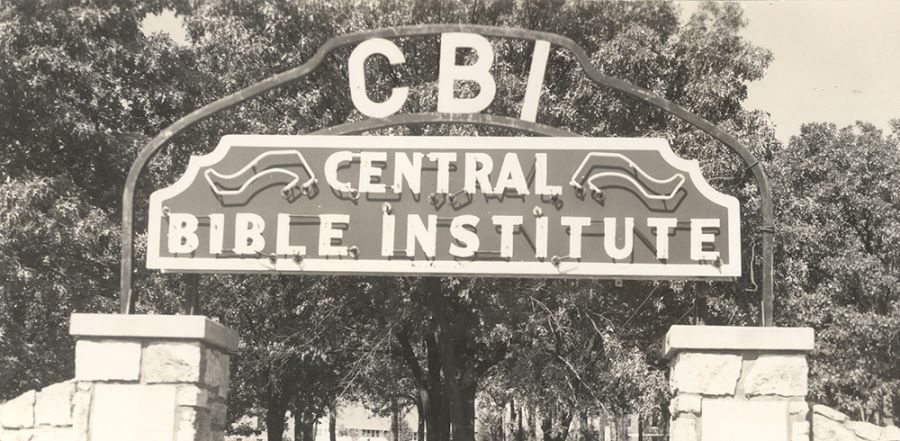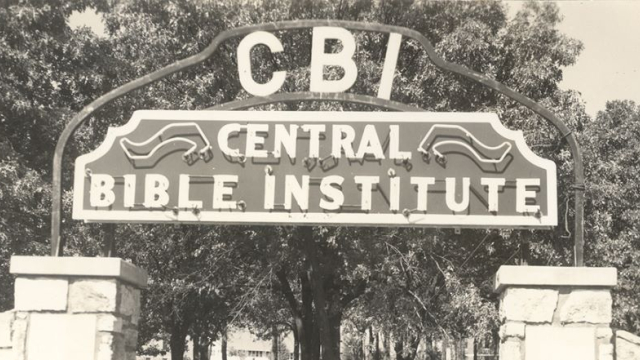Click to join the conversation with over 500,000 Pentecostal believers and scholars
Click to get our FREE MOBILE APP and stay connected
| PentecostalTheology.com




This Week in AG History —September 30, 1922
By Ruthie Edgerly Oberg
Originally published on AG News, 29 September 2022
One of the reasons for the formation of the Assemblies of God in 1914 was to establish schools to train ministers and missionaries. Eight years later, the Sept. 30, 1922, issue of the Pentecostal Evangel announced the opening of Central Bible Institute (CBI, later Central Bible College) in Springfield, Missouri, to address that need.
Local efforts to establish ministerial training schools had been undertaken in various parts of the country. However, it was soon determined that individual effort could never hope to achieve the results possible through united endeavors.
The first ministerial training school owned and operated by the General Council of the Assemblies of God opened its doors in 1920 in the small town of Auburn, Nebraska. Midwest Bible School remained open for only one year. The school’s remote location made it difficult to attract faculty or to provide jobs for students.
Assemblies of God leaders sought a more suitable location to establish a new school. In the summer of 1922, they decided to locate the school in Springfield. D.W. Kerr and his son-in-law, Willard Peirce, offered themselves for this work. Just six years earlier, Kerr served as the primary drafter of the Statement of Fundamental Truths. Kerr and Peirce had a track record of stabilizing educational institutions and had set Assemblies of God schools in Los Angeles and San Francisco on sure footing. They moved to Springfield to form the nucleus of the faculty and management of CBI.
It was felt that the move to Springfield, the new headquarters city of the General Council, afforded this new school several advantages. Close proximity to the executive leadership would provide counsel and oversight. The Fellowship’s paper, the Pentecostal Evangel, would offer information and publicity. Ministers and missionaries traveling to the area would be available for encouragement and as an example for the student body.
Outside of those advantages there were few other expedient assets to offer to the fledgling school. There were no buildings or dormitories available. The Fellowship had followed a “pay as you go” policy and there was little willingness to shoulder debt for new buildings. All there was to offer to Kerr was the basement of a local church, Central Assembly of God on the corner of Campbell and Calhoun Streets, and the homes of church members who were willing to house students.
Kerr and his team set about plastering and painting the basement rooms to prepare for the influx of the first class of students, numbering about 50. They fitted out one classroom, a kitchen, a dining area, and office. Kerr admitted in the Evangel’s announcement, “While we are necessarily crowded and handicapped in our limited temporary quarters, yet we are sure of the continued blessings of God on these humble beginnings … great oaks from little acorns grow.” Kerr encouraged contributions for the young people studying for ministry as “two hundred and fifty dollars will support a student for one school year, meeting all expenses.”
Two years later, 15 acres on the northern outskirts of the city had been secured through the generous donations of local businessmen. Three of the leaders, Kerr, J. W. Welch, and E.N. Bell, knelt in prayer on this tract of land at North Grant Avenue, consecrating it to God for the “training of ministers and missionaries.”
With the funds in hand and further offerings received in response to appeals made through the Pentecostal Evangel, the first building was erected in 1924 and a student body of 106 moved onto the new campus. Adding to its growth was the merging of other smaller schools, such as Bethel Bible Training Institute of Newark, New Jersey, in 1929, with the Springfield school.
Kerr later testified that he had some misgivings whether the project would be successful, given its meager beginnings in 1922, but he felt the Lord ask him as He did Moses, “What has thou in thine hand?” He responded, “Just a basement, Lord!” He felt the assurance that the same Lord who wrought wonders with Moses’ staff would be faithful to do great things with that tiny basement school at Central Assembly of God.
The history of the Pentecostal movement can testify to God’s faithfulness as the graduates of Central Bible Institute and Central Bible College (now consolidated with Evangel University and Assemblies of God Theological Seminary) continue to provide the Assemblies of God with thousands of pastors, evangelists, missionaries, and teachers impacting the world with the Pentecostal message they were taught in the classrooms of the basement at Central Assembly, the campus at 3000 North Grant, and the current university on North Glenstone.
Read Kerr’s announcement about CBI on page 4 of the Sept. 30, 1922, issue of the Pentecostal Evangel.
Also featured in this issue:
• “Be Filled with the Spirit” by W.T. Gaston
• “Questions and Answers” by E.N. Bell
• “A New Heavens and A New Earth” by S.A. Jamieson
And many more!
Click here to read this issue now.
Pentecostal Evangel archived editions courtesy of the Flower Pentecostal Heritage Center.
Do you have Pentecostal historical materials that should be preserved? Please consider depositing these materials at the Flower Pentecostal Heritage Center (FPHC). The FPHC, located in the Assemblies of God national offices, is the largest Pentecostal archive in the world. We would like to preserve and make your treasures accessible to those who write the history books.
Flower Pentecostal Heritage Center
1445 North Boonville Avenue
Springfield, Missouri 65802 USA
Phone: 417.862.1447 ext. 4400
Toll Free: 877.840.5200
Email: archives@ag.org
Website: www.iFPHC.org




Most Talked About Today